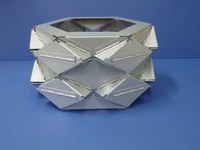Origami Structures research undertaken by the Special Structures Group, Department of Engineering Science, University of Oxford

Origami Structures
In recent decades origami folding, a traditional art form of paper folding, has been of increasing interest to mathematicians and engineers. Mathematicians are more interested in the geometrical aspects of origami objects such as foldability of origami patterns, especially foldability of developable surfaces. Engineers, on the other hand, are finding that traditional geometry and folding used for artistic paper models can be readily parameterised and applied to the development of new structures and devices. Since most of the sheet materials used in engineering applications are relatively rigid in comparison with paper, particular attention has been drawn on to rigid origami, a subset of origami that permit continuous motion between folded states along the pre-determined folding creases without the need for twisting or stretching of the facets. This allows the patterns to be readily manufactured from modern materials such as plastic, metal, or carbon-fibre sheets, producing patterns that are sufficiently strong and durable to be of use in large-scale applications.
The research on origami here in Oxford focuses on developing morphing structures and energy absorption structures/devices utilising origami patterns. A summary of our past research can be found here.
Deployable morphing structures


Folding of a rigid shopping bag

Morphing grid structures
Energy absorption structures/devices

The origami crash box that absorbs 50% more energy than the existing crash boxes.

Traditional foldcore, indented foldcore and foldcore with curved creases for sandwich panels.

Folded grid core utilising origami crash box concept.






Fore future development, please click here.
